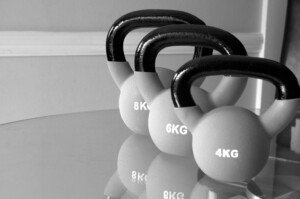
Get ready for the kettlebell heavy pushup — for those who dare, for those who find pumping out lots of plain ‘ol pushups is just way too easy.
Pushups need not be fancy to be tough and intense.
For people who are no longer challenged by the conventional pushup, and who don’t want to hassle around with the placement of weight plates on their back, or fussing around with tension bands to add resistance, the kettlebell heavy pushup is just for you.
Equipment needed: kettlebell (ideally two or three of different weights), dip belt and two high exercise stools.
Getting Started
It would be wise to do a set of non-weighted pushups using the stools, to get used to how it feels to perform this exercise in this fashion.
The stools are placed apart so that one’s hands are on the top of one stool, and the tips of their feet are on the second stool: a standard pushup position.
From here, simply do a warm-up set. If you find that your middle is sagging towards the space between the two stools, figure out why this is happening.
It may very well be bad form. During a pushup, the body is supposed to be straight as a board, like a plank of wood. Imagine a group of military personnel doing pushups.
On the other hand, if a trainee cannot keep their body straight, they are not strong enough to perform pushups with solid form.
Bad form (either due to unawareness or weakness) should not be tolerated in the pushup any more than it’s tolerated in the squat.
Though bad form in a pushup isn’t as risky as bad squat form, it will still interfere with achieving desired results.
How much added weight do you think you need to be challenged by a set of pushups?
Select that weight of a kettlebell. However, select two more weights; one lighter and one heavier, just in case your judgment is a little off, or in the event that you want to do drop sets.
Working Sets
Slip into a dip belt and attach a kettlebell, then position yourself on the stools in a pushup start position. The arms are extended, feet on toes, body straight, kettlebell hanging below midsection.
Now lower into a pushup. The stools should be high enough so that when you lower, the kettlebell does not touch the floor. Push back up. A variation is to place the hands over the sides of the stool.
What makes this kind of weighted pushup superior to bands or a plate placed on the back, is that the added resistance is disconnected from the body.
In tension band pushups, the bands surround the body and are integrated with the trainee. Of course, a plate on the back is on the body.
The kettlebell hangs and even swings a bit. Even the tiniest swinging adds to the workout.
Plus, because it’s disconnected from the body, it produces a unique element to the so-called resistance arm.
In a regular pushup, as well as tension band style, the resistance arm is not extended.
The resistance arm is the athlete’s body itself. When one adds a plate to the back, the resistance arm is extended only by the width of the plate, which is negligible.
In the case of a suspended kettlebell, the resistance arm is extended for whatever the length is from the attachment point of the dip belt to the bottom of the kettlebell; that’s a lot of extra vertical resistance.
Is there a way to increase intensity without increasing kettlebell weight? Yes, depending on available equipment.
If the feet are elevated higher than the hands, this will make the pressing harder.
Give this a try if you can find two elevated surfaces of different heights, but that will get you high enough to prevent the kettlebell from touching the floor.
Why not just do elevated regular pushups for increased resistance?
Why bother hooking up a kettlebell? The more that the feet are elevated, the more that the muscle recruitment shifts from chest to shoulders.
This is why an elevated pushup is harder than a flat one; the shoulders are forced to take more work, and shoulders aren’t as strong as the pectoralis muscles of the chest.
The most elevated form of a pushup is the handstand press; this is all shoulders and very difficult.
It should be clear now why simply elevating the feet higher and higher isn’t a practical solution for those wanting to create a heavier pushup.
The kettlebell heavy pushup keeps the chest as much involved as in a regular pushup, without the trainee having to hassle with the balancing moves of placing each hand on a medicine ball for “extra intensity” or doing other funky things like using only the fingertips or clapping in between.


























